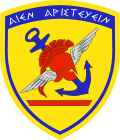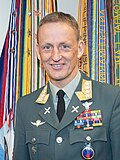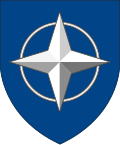| Member | CHOD | Member | CHOD | Member | CHOD |

Chief of the General Staff of
Albania
Member since
1 April 2009 | 
Lieutenant General
Arben Kingji [ de; nl ]
of the
 Albanian Land Force Albanian Land Force | 
Chief of Defence of
Belgium
Member since
24 August 1949 | 
General
Frederik Vansina
of the
 Belgian Air Component Belgian Air Component | 
Chief of Defence of
Bulgaria
Member since
29 March 2004 | 
Admiral
Emil Eftimov [ bg; de; he ]
of the
 Bulgarian Navy Bulgarian Navy |

Chief of the Defence Staff of
Canada
Member since
24 August 1949 | 
General
Jennie Carignan
of the
 Canadian Army Canadian Army | 
Chief of the General Staff of
Croatia
Member since
1 April 2009 | 
Colonel General
Tihomir Kundid
of the
 Croatian Army Croatian Army | 
Chief of the General Staff of the
Czech Republic
Member since
12 March 1999 | 
Army General
Karel Řehka
of the
 Czech Special Forces Czech Special Forces |

Chief of Defence of
Denmark
Member since
24 August 1949 | 
General
Michael Hyldgaard [ da ]
of the
 Royal Danish Army Royal Danish Army | 
Commander of the Defence Forces of
Estonia
Member since
29 March 2004 | 
Lieutenant General
Andrus Merilo
of the
 Estonian Land Forces Estonian Land Forces | 
Chief of Defence of
Finland
Member since
4 April 2023 | 
General
Janne Jaakkola
of the
 Finnish Army Finnish Army |

Chief of the Defence Staff of
France
Member since
24 August 1949 [a] | 
Général d'Armée Aérienne
Fabien Mandon
of the
 French Air and Space Force French Air and Space Force | 
Inspector General of the Bundeswehr of
Germany
Member since
6 May 1955 [b] | 
General
Carsten Breuer
of the
 German Army German Army | 
Chief of the General Staff of
Greece
Member since
18 February 1952 | 
General
Dimitrios Choupis [ el ]
of the
 Hellenic Army Hellenic Army |

Chief of the General Staff of
Hungary
Member since
12 March 1999 | 
Colonel General
Gábor Böröndi
of the
 Hungarian Ground Forces Hungarian Ground Forces | 
Director of the Security and Defence Department of
Iceland
Member since
24 August 1949 | 
Jónas G. Allansson
| 
Chief of the Defence Staff of
Italy
Member since
24 August 1949 | 
General
Luciano Portolano
of the
 Italian Army Italian Army |

Commander of the Joint Headquarters of
Latvia
Member since
29 March 2004 | 
Major General
Kaspars Pudāns
of the
 Latvian National Guard Latvian National Guard | 
Chief of Defence of
Lithuania
Member since
29 March 2004 | 
General
Raimundas Vaikšnoras
of the
 Lithuanian Land Force Lithuanian Land Force | 
Chief of Defence of
Luxembourg
Member since
24 August 1949 | 
General
Steve Thull
of the
 Luxembourg Army Luxembourg Army |

Chief of the General Staff of
Montenegro
Member since
5 June 2017 | 
Brigadier General
Miodrag Vuksanović of the
 Montenegrin Ground Army Montenegrin Ground Army | 
Chief of Defence of the
Netherlands
Member since
24 August 1949 | 
General
Onno Eichelsheim
of the
 Royal Netherlands Air and Space Force Royal Netherlands Air and Space Force | 
Chief of the General Staff of
North Macedonia
Member since
27 March 2020 | 
Major General
Saško Lafčiski
of the
 North Macedonian Special Forces North Macedonian Special Forces |

Chief of Defence of
Norway
Member since
24 August 1949 | 
General
Eirik Kristoffersen
of the
 Norwegian Army Norwegian Army | 
Chief of the General Staff of
Poland
Member since
12 March 1999 | 
General
Wiesław Kukuła
of the
 Polish Territorial Defence Forces Polish Territorial Defence Forces | 
Chief of the General Staff of
Portugal
Member since
24 August 1949 | 
General
José Nunes da Fonseca [ he; pt ]
of the
 Portuguese Army Portuguese Army |

Chief of the General Staff of
Romania
Member since
29 March 2004 | 
General
Gheorghiță Vlad [ he ]
of the
 Romanian Land Forces Romanian Land Forces | 
Chief of the General Staff of
Slovakia
Member since
29 March 2004 | 
General
Daniel Zmeko
of the
 Slovak Ground Forces Slovak Ground Forces | 
Chief of the General Staff of
Slovenia
Member since
29 March 2004 | 
Lieutenant Colonel General
Robert Glavaš
of the
 Slovenian Ground Force Slovenian Ground Force |

Chief of the Defence Staff of
Spain
Member since
30 May 1982 | 
Admiral General
Teodoro Esteban López Calderón
of the
 Spanish Navy Spanish Navy | 
Chief of Defence of
Sweden
Member since
7 March 2024 | 
General
Michael Claesson
of the
 Swedish Army Swedish Army | 
Chief of the General Staff of
Turkey
Member since
18 February 1952 | 
General
Selçuk Bayraktaroğlu
of the
 Turkish Land Forces Turkish Land Forces |

Chief of the Defence Staff of the
United Kingdom
Member since
24 August 1949 | 
Air Chief Marshal
Sir Richard Knighton
of the
 Royal Air Force Royal Air Force | 
Chairman of the Joint Chiefs of Staff of the
United States
Member since
24 August 1949 | 
General
Dan Caine
of the
 United States Air Force United States Air Force | | |







































































